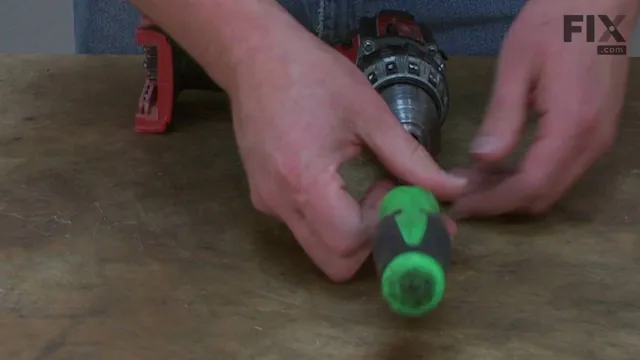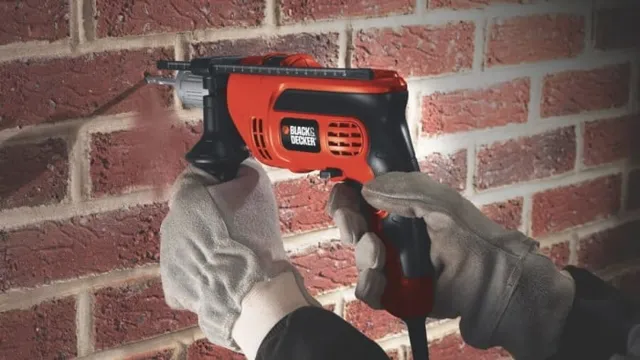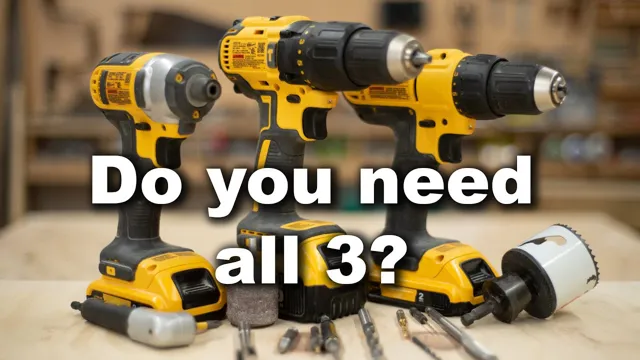
Drilling into concrete can be a tedious and challenging task, especially when you don’t have a hammer drill. But fear not, because we’ve got you covered! There are several ways to drill into concrete without a hammer drill, and we’re here to show you how. First off, let’s talk about why you might need to drill into concrete in the first place.
Perhaps you’re looking to install a new shelf or anchor some furniture to the wall. Maybe you’re repairing some concrete cracks or installing new plumbing fixtures. Whatever the reason may be, you don’t necessarily need a hammer drill to get the job done.
One method is to use a regular power drill with masonry bits specifically designed for concrete. These bits are made of hardened steel and feature a carbide tip that can bite into the dense material. However, it’s important to note that regular power drills aren’t as powerful as hammer drills, so drilling may take longer and require more effort.
Another way to drill into concrete is to use a rotary hammer drill. These drills are similar to hammer drills but have a more powerful motor and use a pneumatic mechanism to create a more forceful impact. While rotary hammer drills can be expensive, they’re ideal for larger projects and can easily handle tough concrete surfaces.
As you can see, there are several ways to drill into concrete without a hammer drill. Depending on the size of your project and your budget, you can choose the method that works best for you. With the right tools and a little bit of patience, you’ll be able to drill through concrete with ease.
Using a Masonry Bit and Power Drill
If you’re wondering if you can drill concrete without a hammer drill, the answer is yes! You can use a masonry bit and power drill to get the job done. While a hammer drill is specifically designed for drilling through concrete and masonry, a regular power drill can still be effective with the right bit. A masonry bit has a carbide tip that can penetrate tough surfaces like concrete.
The key is to use the drill in short bursts, applying firm pressure as you go. It’s important to wear protective gear, especially eye protection, and to make sure your drill bit is sharp before starting. Keep in mind that this method may take longer and be more difficult than using a hammer drill, but with patience and persistence, you can successfully drill into concrete without a specialized tool.
Step 1: Mark the Spot
When it comes to installing shelves or hanging pictures on the wall, the first step is to mark the spot where you want to place them. To do this, you’ll need a power drill and a masonry bit. A masonry bit is designed specifically for drilling into hard surfaces like brick, concrete, and stone.
Start by choosing the spot where you want to hang your item and use a pencil to mark the center point. Next, attach the masonry bit to your power drill and set it to the drill mode. Hold the drill perpendicular to the wall and start drilling at a slow speed.
Apply gentle pressure while keeping the drill steadily in place. Once you’ve made a hole in your desired spot, wipe away any debris or dust that may have accumulated. Your spot is now marked, and you’re ready to install your shelf or hang your picture!

Step 2: Use a Masonry Bit
When it comes to drilling into masonry, using the right kind of drill bit is essential for success. A masonry bit is designed specifically for drilling into brick, concrete, or stone, and is equipped with a carbide tip that can handle tough surfaces. To use a masonry bit, you’ll need a power drill that’s capable of running at a low speed and high torque, as well as a hammer drill function for even greater power.
Once you’re ready to start drilling, you should mark the spot where you want to make the hole with a permanent marker or masking tape. Hold the drill perpendicular to the surface and apply even pressure as you start drilling. It’s important to let the drill do the work and not push too hard, as this can cause the bit to overheat.
Remember to pause intermittently to allow debris to clear from the hole and avoid overloading the drill motor. With patience and the right technique, you’ll have a perfectly drilled hole in no time.
Step 3: Start Drilling Slowly
Once you’ve secured your masonry bit and power drill, it’s time to start drilling slowly into your concrete surface. This step is crucial to ensure that you don’t damage your equipment or the concrete itself. It’s important to maintain consistent pressure and keep the drill straight to avoid any wobbling.
Depending on the thickness of your concrete, you may need to apply more pressure, but it’s important not to rush the process. Take your time and let the drill do the work. Once you’ve made a small indentation into the concrete, you can increase the speed of the drill.
Remember, patience is key when it comes to drilling into concrete. By taking your time and starting slow, you’ll be on your way to a successful project in no time.
Step 4: Apply Steady Pressure and Keep Drilling
When it comes to drilling into masonry, using the right bit and power drill is crucial. Once you’ve got the right tools, it’s time to start drilling. Begin by applying a steady pressure to the drill, keeping it as level as possible.
This will help ensure that the hole stays straight and doesn’t veer off course. As you drill, it’s important to keep the drill spinning at a consistent speed – this will help prevent the bit from overheating or getting stuck. To make things easier, you can periodically pull the bit out of the hole to clear any accumulated debris.
Once you’re finished drilling, be sure to clean up any remaining dust or debris by using a soft brush or vacuum. With a bit of practice, you’ll be able to drill into masonry with confidence and ease. So go ahead and give it a try – your home improvement projects will thank you later!
Step 5: Clean the Hole and Repeat if Necessary
After drilling the hole in your masonry wall, it’s essential to clean it out thoroughly to ensure proper anchoring of the screw or anchor. A masonry bit and power drill are the perfect tools for this task. Begin by removing the dust and debris from the hole using a stiff-bristled brush or vacuum.
Next, insert the masonry bit into the hole and drill in a few millimetres to clear out any remaining debris. You can also use a wire brush attachment on your power drill to ensure a thorough cleaning. If there’s still debris left inside the hole, repeat the process until the hole is completely clean.
Remember, a clean hole is crucial to providing a strong and secure anchor for any fittings or fixtures. By following this step, you’ll be sure that your anchors or screws are securely fixed into the masonry wall, providing the stability you need.
Using a Rotary Hammer Drill Bit and Regular Drill
Can you drill concrete without a hammer drill? The short answer is yes, but it may require some extra effort. While a hammer drill is the best tool for drilling into concrete, there are alternatives available. You can use a rotary hammer drill bit and a regular drill to work through concrete surfaces.
However, it’s important to keep in mind that this method may take longer and require a bit more pressure than a hammer drill. Additionally, the regular drill may overheat and become damaged if you don’t take breaks and allow it to cool down periodically. So, while you can drill concrete without a hammer drill, it’s important to be cautious and patient throughout the process.
Step 1: Attach the Rotary Hammer Bit
If you’re wondering how to use a rotary hammer drill bit and a regular drill, the first step is to attach the bit to your rotary hammer drill. Make sure the drill bit you’re using is compatible with your rotary hammer drill and that the shank size matches. To attach the bit, slide it into the chuck of the rotary hammer drill and tighten it securely.
You don’t want the bit to come loose during drilling, which could damage the bit or pose a safety hazard. Once the bit is attached, you’re ready to move on to the next step in your drilling project. By using the right drill bit, you can achieve smooth, clean holes in concrete or other tough materials with ease.
Don’t forget to wear appropriate safety gear, including eye and ear protection, when using a rotary hammer drill bit. Following these steps will ensure that you get the most out of your rotary hammer drill and bit.
Step 2: Place the Bit Against the Concrete
When it comes to drilling into concrete, it’s essential to have the right tools for the job. One of the most important pieces of equipment is the drill bit. If you’re using a rotary hammer drill bit and a regular drill, the first step is to choose the right bit size for your project.
Once you’ve determined the right size, you’ll need to place the bit against the concrete. This process can be a bit tricky, but it’s essential to get it right to ensure a successful project. To start, position the bit on the concrete’s surface, making sure it’s perfectly perpendicular to the surface.
Next, apply steady downward pressure and begin drilling. It’s important to keep the drill bit lubricated with water to prevent it from overheating and becoming damaged. Take your time and be patient, as drilling into concrete can take some time.
With the right technique and a little bit of practice, you’ll be able to drill into concrete like a pro!
Step 3: Apply Steady Pressure and Keep Drilling
When using a rotary hammer drill bit and a regular drill, applying steady pressure and keeping the drilling motion consistent is crucial. This is because rotary hammer drills work by using a piston that drives the bit forward and back quickly, chipping away at the material. As a result, it’s important to guide the drill bit smoothly, otherwise, you risk breaking the bit or causing unwanted damage to your workpiece.
By applying steady pressure with the drill, you can keep the bit in contact with the material, helping to maintain a consistent drilling speed. Remember, it’s also important to keep the bit sharp and to use proper lubricant to ensure smooth and clean cuts. With a little practice, you’ll be drilling through even the toughest materials like a pro!
Conclusion and Safety Tips
So, can you drill concrete without a hammer drill? The answer may shock you – yes, you actually can! It may seem as unlikely as teaching a fish to ride a bicycle, but with the right tools and techniques, anyone can bore into that tough, hardened surface. However, it’s important to remember that a hammer drill was specifically designed for this task, and can make your job much easier and faster. So, if you’re feeling adventurous and want to try it out, go for it.
But if you’re looking for a simpler solution, investing in a hammer drill is definitely the way to go – it’s like giving Superman his cape!”
FAQs
What is the best way to drill concrete without a hammer drill?
While a hammer drill is preferred, you can use a regular drill with a masonry bit and apply steady pressure while drilling.
Can I use a regular drill bit for drilling concrete?
No, a regular drill bit will not work on concrete. You need to use a masonry bit designed specifically for concrete.
Can I drill into reinforced concrete with a regular drill?
It’s not recommended to drill into reinforced concrete with a regular drill. You will need a hammer drill or a rotary hammer with a masonry bit.
How do I know what size masonry bit to use for concrete?
The size of the masonry bit depends on the size of the hole you need. Measure the diameter of the anchor or screw you plan to use and choose a bit slightly larger than that.
What kind of safety precautions should I take when drilling concrete?
Always wear eye protection, a dust mask, and earplugs. Keep your hands away from the drill bit while it’s spinning, and make sure the drill is securely locked into the chuck.
Can I drill concrete with a cordless drill?
Yes, you can drill concrete with a cordless drill, but it may not be as powerful as a corded drill or hammer drill. Make sure the battery is fully charged and use a masonry bit.
What is the difference between a hammer drill and a rotary hammer?
A hammer drill uses a back and forth motion to hammer the bit into the material, while a rotary hammer also rotates the bit for more efficient drilling. Rotary hammers are more powerful than hammer drills and better suited for drilling into concrete.








